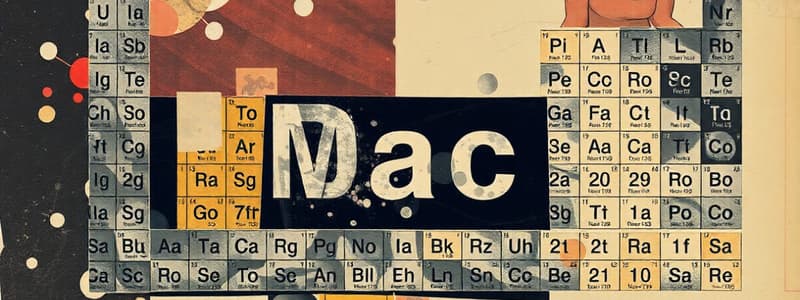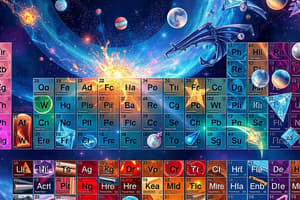Podcast
Questions and Answers
Describe the general location of metals, non-metals, and metalloids on the periodic table.
Describe the general location of metals, non-metals, and metalloids on the periodic table.
Metals are generally located on the left and bottom, non-metals on the right and top, and metalloids in between, following a 'zig-zag' pattern.
How does the electronic configuration of noble gases relate to their chemical reactivity?
How does the electronic configuration of noble gases relate to their chemical reactivity?
Noble gases have a stable electronic configuration, meaning they do not need to gain or lose electrons. This makes them chemically unreactive.
Explain, in terms of electron transfer, what happens when a metal and a non-metal combine to form an ionic compound.
Explain, in terms of electron transfer, what happens when a metal and a non-metal combine to form an ionic compound.
The metal atom transfers electron(s) to the non-metal atom, forming positive and negative ions which are then attracted to each other, forming an ionic bond.
How does the number of occupied electron shells relate to the period number of an element?
How does the number of occupied electron shells relate to the period number of an element?
What is the relationship between valence electrons and an element’s group number?
What is the relationship between valence electrons and an element’s group number?
How is a stable electron arrangement achieved in covalent bonds?
How is a stable electron arrangement achieved in covalent bonds?
What is the octet rule and how does it relate to the formation of ions?
What is the octet rule and how does it relate to the formation of ions?
How does the process of precipitation occur when mixing aqueous solutions?
How does the process of precipitation occur when mixing aqueous solutions?
Differentiate between atomic number and mass number.
Differentiate between atomic number and mass number.
What are the key physical properties used to differentiate between metals and non-metals?
What are the key physical properties used to differentiate between metals and non-metals?
Define the terms monatomic and diatomic, providing an example of an element that exists in each state.
Define the terms monatomic and diatomic, providing an example of an element that exists in each state.
What is an ion, and how does it form?
What is an ion, and how does it form?
What is the role of valency when indicating the chemical formula of a transition metal?
What is the role of valency when indicating the chemical formula of a transition metal?
What is a chemical symbol and a chemical formula?
What is a chemical symbol and a chemical formula?
What are the properties of metalloids?
What are the properties of metalloids?
How does the electronic configuration determine the position of the element in the Periodic Table?
How does the electronic configuration determine the position of the element in the Periodic Table?
What must you know in order to predict whether a precipitate will form?
What must you know in order to predict whether a precipitate will form?
What is the difference between a solution and a precipitate?
What is the difference between a solution and a precipitate?
What are the classifications for the charges of simple ions when they are in Group 1 or Group 7?
What are the classifications for the charges of simple ions when they are in Group 1 or Group 7?
How are ionic compounds named? (You may reference monatomic anions.)
How are ionic compounds named? (You may reference monatomic anions.)
Flashcards
Properties of Metals
Properties of Metals
Shiny, dense, and good conductors of heat and electricity.
Properties of Non-metals
Properties of Non-metals
Dull and brittle; poor conductors of heat and electricity.
Metalloids
Metalloids
Elements with properties between metals and non-metals; semi-conductors.
Periodic Table
Periodic Table
Signup and view all the flashcards
Metals on Periodic Table
Metals on Periodic Table
Signup and view all the flashcards
Non-metals on Periodic Table
Non-metals on Periodic Table
Signup and view all the flashcards
Monatomic
Monatomic
Signup and view all the flashcards
Diatomic
Diatomic
Signup and view all the flashcards
Atomic Number
Atomic Number
Signup and view all the flashcards
Mass Number
Mass Number
Signup and view all the flashcards
Ion
Ion
Signup and view all the flashcards
Ionic Bonding
Ionic Bonding
Signup and view all the flashcards
Electronic Configuration
Electronic Configuration
Signup and view all the flashcards
Noble Gases
Noble Gases
Signup and view all the flashcards
Stable Electron Arrangement
Stable Electron Arrangement
Signup and view all the flashcards
Ionic Compound Formation
Ionic Compound Formation
Signup and view all the flashcards
Covalent Bonds
Covalent Bonds
Signup and view all the flashcards
Precipitation
Precipitation
Signup and view all the flashcards
Solution
Solution
Signup and view all the flashcards
Metal/Non-Metal Compound
Metal/Non-Metal Compound
Signup and view all the flashcards
Study Notes
Metals vs. Non-metals vs. Metalloids
- Metals are shiny, dense, and solid at room temperature.
- Metals are good conductors of heat and electricity.
- Metals are malleable and ductile.
- Metals generally have high melting points and readily lose electrons.
- Non-metals are dull, brittle, and poor conductors of heat and electricity.
- Metalloids have properties intermediate between metals and non-metals.
Periodic Table
- The Periodic Table classifies elements by atomic number and groups elements with similar properties.
- Metals are on the left and bottom (except Mercury).
- Non-metals are on the right and top (except Boron).
- Metalloids are between metals and non-metals, forming a "zig-zag" pattern.
- Chemical families include Alkali metals, Alkali Earth metals, Halogens, and Noble gases.
Key Definitions
- Monatomic: An element existing as single, uncombined atoms.
- Diatomic: An element existing as two of the same atoms bonded together.
- Atomic number: The number of protons in an atom's nucleus.
- Mass number: The number of protons plus neutrons in an atom's nucleus.
- Ion: An atom or group of atoms with a positive or negative charge due to an imbalance of protons and electrons.
- Ionic bonding: The attraction of positive and negative ions in a lattice structure.
Electronic Configuration
- Electrons are arranged in shells around the nucleus.
- Electronic configuration determines an element's position on the Periodic Table.
- The number of occupied electron shells indicates the period number.
- The number of valence electrons indicates the group number.
Ion Formation and Noble Gases
- Noble gases have a stable electronic configuration, making them chemically unreactive.
- Group I elements lose a valence electron to form positively charged ions (e.g., K+).
- Group VII elements gain an electron to form negatively charged ions (e.g., Cl-).
- Metals and non-metals react to form ionic compounds.
- Electrons are transferred from the metal atom to the non-metal atom, creating positive and negative ions that attract each other.
Ionic Compounds
- An ionic formula is determined by considering the charges of the ions involved.
- Valency must be stated for ionic compounds containing transition metal ions using Roman numerals (e.g., lead (II) sulphate PbSO4, copper (II) hydroxide Cu(OH)2).
- Non-metal atoms share electrons to achieve a stable arrangement, forming covalent bonds.
- Non-metals form covalent compounds and nearly always exist as molecules (e.g. Chlorine Cl2)
Formulas and Chemical Reactions
- A chemical reaction creates a new substance and is usually difficult to reverse
- Important polyatomic ions to memorize: NH4+, CO32-, OH-, NO3-, SO42-
Chemical Equations
- Steps for balancing chemical equations involving ionic compounds and molecules should be followed excluding state
Solutions and Precipitation
- A solution is a homogenous mixture of two or more substances
- Precipitation occurs when two aqueous solutions of soluble salts mix to produce an insoluble salt precipitate.
- Precipitation happens when ions in solution combine to form a compound with low water solubility, forming solid particles called a precipitate.
- Predicting precipitate formation requires knowledge of substance solubilities.
Naming Ionic Compounds
- Monatomic anions are named with the suffix "-ide”.
- Polyatomic ions are anions generally ending in "ate" (usually an extra oxygen ion) or "ite" (usually one oxygen ion less).
Studying That Suits You
Use AI to generate personalized quizzes and flashcards to suit your learning preferences.




